The world map of a trace element

Selenium is important to all living creatures. A unique project is mapping the worldwide distribution of this trace element and is trying to find the reasons for the lack of it. By Alexandra Bröhm
(From "Horizons" no. 112 March 2017)
The trace element selenium (Se) only occurs in tiny concentrations and yet is essential to living beings. It usually gets less attention than its big brothers iron, iodine or zinc, but neither human beings nor animals can do without it. This was reason enough for the biogeochemist Lenny Winkel from the Department of Environmental Sciences at ETH Zurich and Eawag to devote herself more intensively to this trace element. And Winkel isn't just looking at it on a molecular level, but as part of a bigger picture. Together with her team, she's investigating what the distribution of selenium looks like across the globe, and what factors determine where it occurs.
Worldwide deficiency
"Basically, we don't know so much about the distribution of trace elements", says Winkel. The concentration of selenium in the soil is different from one region to the next. Humans absorb selenium primarily through plant-based foodstuffs. But even in plants, the selenium content varies greatly according to where they grow.
There are estimates that between half a million and a million people across the world suffer from selenium deficiency. In Europe – and thus in Switzerland too – the problem is not so much the concentration of selenium in the soil, but the amount of it that's absorbed by plants, says Winkel. But this does not mean that everyone in Switzerland is necessarily suffering from a selenium deficiency, because we rarely subsist on purely local products.
Mongolia's selenium chickens
"The concentration of selenium in the earth is also decreasing everywhere on account of global warming", says Winkel. She and her team have recently published the first-ever global map of selenium distribution in the soil. It's not just Europe that's affected, but other areas on other continents too. In Mongolia, the authorities began a programme in 2016 to give chickens feed that has been enriched with selenium. The eggs produced by these chickens could help to reduce the deficiency symptoms among the population.
Different climate and soil parameters determine how much selenium is concentrated in the soil. As a rule of thumb: if the soil is dry, the selenium content is usually too low. But it's not just the amount of rainfall that determines the concentration of it. The condition of the soil plays an important role, as does the amount of organic carbon in it. This organic material binds with the selenium and keeps it longer in the soil. "Lenny Winkel's research project is very important – and it's unique", says Markus Lenz of FHNW School of Life Sciences, who is also researching into selenium. There are few comparable projects that deal with the global distribution of trace elements. Nor is selenium easy to investigate, because it has a highly complex chemistry and occurs in the environment in different bonding forms.
It is also still unclear to what extent the phytoplankton in the oceans play a role in the global distribution of this trace element. This is something that Winkel's team wants to investigate further. Only if we know more about the global distribution channels of selenium can we hope to take measures to combat its deficiency in specific areas – a deficiency that climate change is only making worse.
Alexandra Bröhm is a science journalist at the Tages-Anzeiger and the SonntagsZeitung.
G.D. Jones et al.: Selenium deficiency risk predicted to increase under future climate change. PNAS (2017)
A building block of amino acids
Selenium is important to human beings because it is part of an amino acid. This trace element helps to prevent cell damage. It also plays an important role in the immune system and participates in the production of the thyroid hormone. The ideal dose of selenium for human beings is relatively small: between 40 and 400 micrograms per day. Below 30 micrograms is regarded as a selenium deficiency, while doses of over 900 micrograms are toxic.